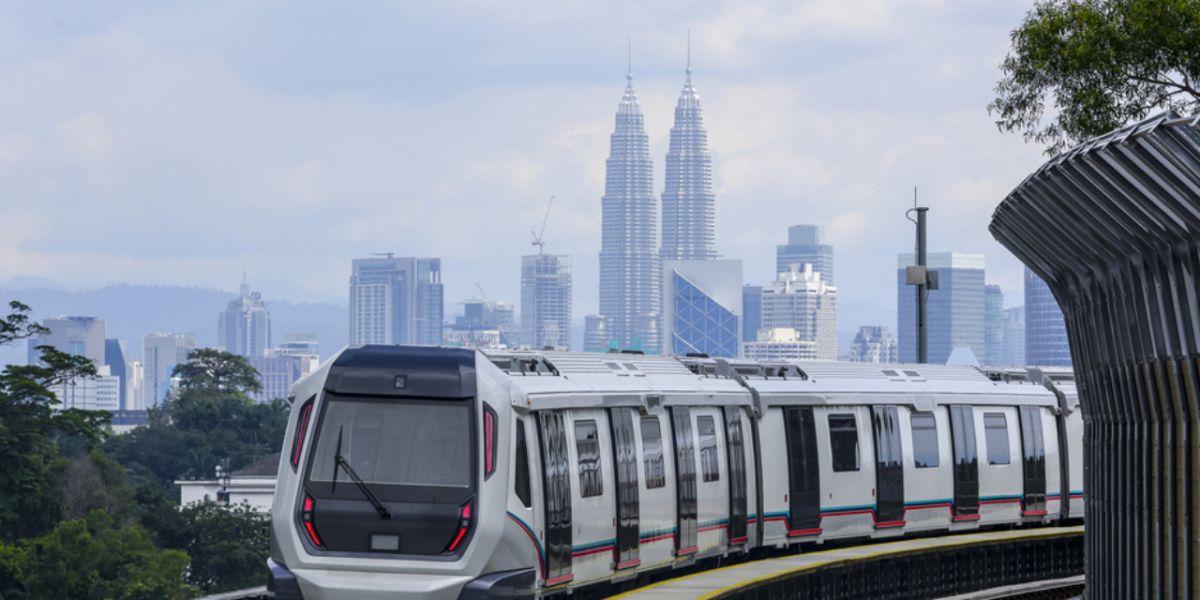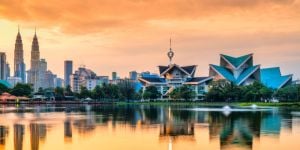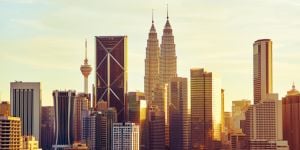
One of the advantages of moving to Kuala Lumpur when settling in Malaysia is the quick access to many facilities and the ease with which one can move around. The Malaysian public transport system is cheap, safe and very reliable, with a network of services linking different areas of Kuala Lumpur and suburbs, as well as with other cities in the country. The city has an excellent public infrastructure, with well-maintained motorways and roads that are pleasant to drive on, provided there are no traffic jams.
Kuala Lumpur is a vibrant megalopolis whose influence extends well beyond Malaysia and the Southeast Asian region. It is undoubtedly the most attractive urban center of the country, despite various decentralization measures launched by the government in recent years. That is why this metropolis of some 8,420,000 inhabitants is, also, by far, the most populated of all Malaysian cities.
One of the consequences of such high population density is the high occurrence of traffic jams in Kuala Lumpur. Adding to this, there is the high cost of cars in Malaysia. Hence, you can understand why most foreigners residing in this city choose not to own a vehicle. Moreover, the cost of maintaining a car is not always practical, unless you and your family are on the road often and you have an assigned parking slot.
Most people in Kuala Lumpur, therefore, prefer to use public transport to commute to and from work. Peak hours are between 7 a.m. and 9 a.m. in the morning, and between 4 p.m. and 7 p.m. in the evening. A simple 10-minute journey can take up to 45 minutes by car during these time slots. Public transport has also a high flow of passengers during these hours, but the journey is usually far less stressful than if you find yourself stuck in daily traffic jams.
Trains in KL
Along with other modes of public transport in Malaysia, Kuala Lumpur's rail network is extremely well developed. KL's main rail services are Light Rapid Transit (LRT), Mass Rapid Transit, Keretapi Tanah Melayu (KTM, aka Malayan Railway Limited). They also have a Monorail service along with two lines serving Kuala Lumpur International Airport, KLIA Express and KLIA Transit (KLIA stands for Kuala Lumpur International Airport).
Most LRT and MTR stations are equipped with multistoried parking facilities, which allow riders to park their own vehicle and board the train. The railway also allows users to transport folding bicycles outside peak hours.
The cost of public transport in Kuala Lumpur varies depending on your method of payment. The Touch N Go card is a cashless payment system that includes charging points across the city and a slight discount on fares. An additional discount is given on a monthly or weekly purchase plan. Most transportation services can be paid for using the Touch N Go card. This ensures smooth transit. The card can be purchased for RM15 at the counter inside the stations and can be topped up for a minimum charge of RM10. The card can also be used to pay road tolls and serves as a payment card at a number of retail and F&B (food counter) outlets.
Light Rail Transit (LRT)
The LRT is a driverless train service that runs along three main arteries: the Kelana Jaya Line, the Sri Petaling Line and the Ampang Line. The LRT is a busy but very efficient service that serves most districts of Kuala Lumpur. It meets most of the transportation needs of locals and other workers in Kuala Lumpur while providing tourists with a convenient way to explore the city. Cabins are air-conditioned and clean, and more stations have been added to increase service capacity to the suburbs.
Mass Rapid Transit (MRT)
The MRT is a fully automatic and remote-controlled train service that connects 31 stations from Sungai Buloh to Kajang, a distance of 51 km. It consists of a 41.5 km elevated track with 24 stations and a 9.5 km tunnel section with seven underground stations. All stations are open to the public from 6 a.m. daily. The departure frequency of these trains is 3 minutes and 30 seconds during peak hours. The MRT is ideal when traveling a little further from the city center to reach the large residential pockets of Kuala Lumpur.
The KTM
The KTM Komuter covers over 280 km and reaches 57 stations. It has two lines: the Port Klang line (Pelabuhan Klang) and the Seremban line. They serve these two peripheral cities of Kuala Lumpur. This is a popular mode of transport for professionals commuting between other areas of the Klang Valley and downtown. You can transfer between the two lines at KL Sentral Station and Putra Station, with other LRT transfer stations along the way. The KTM is often crowded, and less efficient in terms of service than the MRT or LRT lines.
The Monorail
Slower than LRT or LRT, the Monorail line operates from 6 am daily. It serves 11 stations, all located between KL Sentral and Titiwangsa. The Monorail is the third rail line owned by the Rapid Rail transport company, along with the LRT and the MRT. The various stops act as interchange stations and serve the most popular areas of the city, including the most touristic areas. During peak hours, trains arrive every five minutes. Be aware that the limited number of cabins and high traffic on the Monorail means that space is often limited onboard. Most people using this line, therefore, travel standing up.
The KLIA Ekspres and KL Transit Train
The KLIA Express (or Ekspres) service is arguably the most convenient way to get to and from the airport. Trains run every 15 minutes during peak hours, and the journey takes only 30 minutes from central Kuala Lumpur to Kuala Lumpur International Airport (KLIA), and 33 minutes to KLIA2. A one-way ticket cost RM55 on the KLIA Express, and a return ticket is charged RM100. The ride is free for children under 6 years old. Only 3 child tickets can be distributed for one adult. It remains a popular mode of transport for anyone who wants to get to the airport quickly and efficiently, and it will most likely be the first public transport you take if you are traveling to Malaysia for the first time. The airport of Kuala Lumpur is the busiest of the country's seven airports.
An equally efficient and fast alternative is the KL Transit Train. It is another means of transport between the city and the airport. The trip is longer, however. The train stops along the way. Otherwise, this is still a good option if you need to travel beyond the metropolis limits, to places like Bandar Tasik Selatan, Putrajaya and Cyberjaya.
Bus services
The city's bus network is less popular than rail services. As a matter of fact, buses are much less efficient and punctual. Timetables only give an indication of the frequency of service. This is obviously due to the recurring traffic congestion on the roads of Kuala Lumpur.
Buses run from 6 am, and fares will vary depending on the length of the journey. The main bus terminals are KL Sentral, KLCC, Maluri, Titiwangsa and Pudu Sentral.
RapidKL is the country's largest bus operator, with 177 routes serving the city. This company also owns the BRT elevated subway line, which connects Setia Jaya station in Sunway and USJ 7 station in Subang Jaya. In addition, there is an extensive network of private bus companies that cater for longer journeys from KL. The price range varies, and trip durations often depend on how fast the bus driver can fill their vehicle. KL Sentral, for example, handles buses to and from Genting Highlands, while Bandar Tasik Selatan Station, connected to TBS Bus Station, serves travelers heading south from Selangor.
Taxis and carpooling
If you do not want to take public transport and want more comfort during your journeys, taxis are an alternative that may appeal to you. Although they tend to be slowed down by traffic, they are indeed more comfortable and cost-effective if you are traveling in a small group. Taxis charge a premium for late-night journeys and operate on a 24-hour basis. The fare, set by the government, starts from RM3 for the first kilometer and increases by RM1.25 for each subsequent kilometer. Consequently, a 9-kilometer trip will cost you RM14.30. The price will be RM126.80 if your destination is 100 kilometers from your starting point. Between midnight and 6 a.m., the base price increases to RM4.50, and you will have to pay RM1.80 for each additional kilometer.
Be careful though! Even if this price base seems very reasonable, some taxi drivers tend to set their own prices, especially if they are transporting foreigners. If you're not careful, the bill can be much higher than expected. You can try to negotiate, but often all the taxis in an area have come together to charge a single price. The taximeter is one solution, but it can be tricky if you don't know the way. Likewise, it is of common knowledge that some drivers, sometimes, make detours to increase the price at the meter. It is worth saving the contact details of any reliable taxi driver you would have used previously. This advice especially applies to those who live outside the city.
The last 5 years have seen many developments in the ride-sharing industry, culminating in mobile apps that allow users to book a car for themselves, or rideshare, for a fraction of the cost of a taxi. Rideshares generally offer a much better deal in terms of service quality and reliability. The system is based on non-cash payments, which means that the prices are already agreed upon at the time of commitment and cannot be rigged. Carpooling has become very popular. It has improved accessibility and mitigated the prices of transport in the city. Kuala Lumpur's most popular apps have been Grab and Go-Jek since Uber left the country in 2018 after selling its business to Grab.
Useful links:
We do our best to provide accurate and up to date information. However, if you have noticed any inaccuracies in this article, please let us know in the comments section below.








